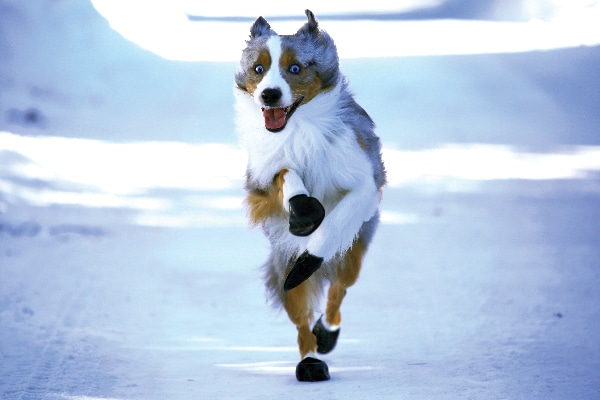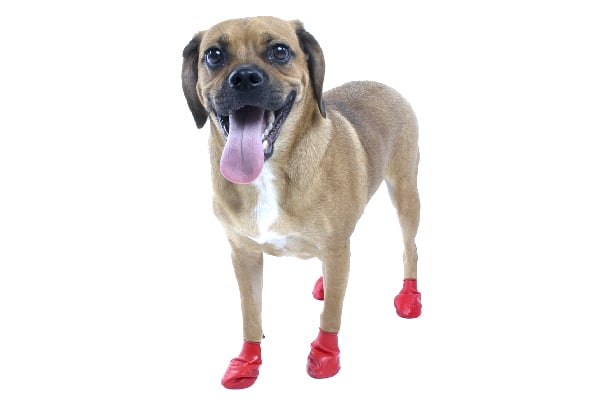My non-dog-loving friends and some of my dog-loving friends get a kick out of the thought of boots for dogs. “Why in the world would they need that?” they ask about dog boots. “They’ve got paws.”
Of course, but dog paw pads are not magical — they aren’t non-destructible barriers between the dog’s foot and the world. The outside is only protected by leathery thick skin, with a shock-absorbing fatty inner layer. This doesn’t stop paws from getting irritated, burned or cut. And, this is where dog boots come in.
But don’t just take my word for it. I talked to several dog boot companies, plus a dog behaviorist to answer the top seven questions typically asked about dog boots.
1. What dog breeds or mixed-breed dogs should wear dog boots?

PawZ dog boots in action.
“All dogs that live where it is cold or hot,” says Michael Friedland, president of PawZ Rubber Dog Boots. “There are no dogs bred for searing-hot pavement, no dogs bred for snow-melt chemicals, and very few dogs are designed to withstand cold and snow. Your dog’s paws are the only exposed area that comes in direct contact with anything on the ground. Without protection, your dogs will lick their paws, ingesting chemicals, pesticides and bacteria, which can have negative impact on your dog’s health.”
Susan Strible, director of marketing for performance dog gear company Ruffwear also adds that boots can be critical gear for working dogs. “After the catastrophic events of 9/11, a journalist asked a rescue worker what they needed most, and the answer was ‘dog boots.’ Working dogs, from canine field researchers to search and rescue teams, have used Ruffwear boots to safely perform their duties. For instance, recent news shared Piper’s story, a dog who chased birds off the airport runway and wore boots as part of his uniform.”
2. What do dog boots protect dogs from?
“Dog boots are valuable for keeping paws safe in extreme environments and weather,” Susan says. “They protect paws from coarse, rocky trails, hot pavement, ice, snow, salt and snowmelt chemicals and more.”
It’s a dangerous world outside, and some of the same reasons we don’t go walking around in bare feet are reasons to protect your dog’s feet. If you’re taking your dog for a long hike or any place that he could encounter any of the following, you might want to consider slipping on some dog boots first.
- Mud
- Ice
- Snow
- Snowmelt chemicals, such as salt
- Hot pavement
- Animal feces
- Foreign bodies, such as glass, splinters or burrs
- Fungus
- Bacteria (Salmonella, Leptospira, Staphylococcus, etc.)
- Poisons like anti-freeze
- Pesticides
- Stinging and biting pests like fire ants and spiders
3. How do you know what kind of boots to get for your dog?

Ultra Paws dog boots in action.
“Great question,” says Lisa Paxton, “lead dog” at active dog gear company Ultra Paws. “Because one style of dog boot will not work in every situation. And that’s why we offer seven different patented styles. Determine why you need dog boots, your price point and then identify the boot that will perform best for your situation.”
Above all, Michael of PawZ says, “They must stay on in order to work. Don’t just buy the ones that look like your shoes — they will fall off, and you will lose them.”
4. How do you make sure you get the right size boots for your dog?
Lisa of Ultra Paws says to first measure your dog’s paws to get the right fit. “Our boots are sized based on the width of the paw. Take a minute to put the paw on a piece of paper, mark the left and right side, and measure the distance. There are a number of ‘me too’ dog boots on the market — the same boots, just with a different company’s label. Buy your boots from a company that specializes in dog gear — we’ve been in business since 1972 and have numerous patents awarded for our innovative gear. You want boots that are going to be comfortable for your dog, stay on and perform.”
Ruffwear has a downloadable Paw Measurement Chart and a video on how to get accurate paw measurements. “Also,” says Susan, “on occasion a dog’s front paws and rear paws vary slightly in size. So, we sell our boots in pairs and in sets of four, as well, to help provide for a good fit.”
5. How do you get your dogs used to wearing the boots?

Close up of Ruffwear.
When I got my dogs their first pair of boots, this was a bit of a challenge, as they didn’t like things on their feet. In all fairness, I had gotten them used to wearing hats, clothes and touching their feet but never on putting anything on them. So I put this question not only to our three dog boot companies but also to dog trainer Jill Breitner, creator of the Dog Decoder app. Jill recommends taking it slowly and making it a positive experience.
- “First bring out the boots for your dog to smell and see,” Jill says. “When she looks or smells the boots, give her a small treat. Put it behind your back, and bring it out again. If she shows any interest, like touching with a paw, smelling, touching with her nose or looking at it, she gets a small treat.” Jill recommends doing this a number of times — perhaps 15 — with a small treat each time (you can use your dog’s dinner kibble if watching calories). “Each time bring it out as new from behind your back,” she says. “If the dog is really engaged and knows how to fetch and bring back, then play with the bootie. Throw it and treat upon retrieval. Do this about 15 times and then leave it alone for a few hours or even a day.” Then repeat the process.
- Next, Jill says to touch the bootie to a foot, and give her a small treat. Do this about 15 times and give treats. Do the same for each foot.
- Then slip the bootie on for a second, take it off, and give her a treat. Do this about 15 times with small treats, and do the same for each foot. “If your dog is struggling at any phase,” Jill warns, “stop and go back to the phase before and for only one success and treat. Leave it alone for a couple of hours or a day and start with the successful phase before moving forward to a more difficult phase.”
- Once your dog is comfortable with the boot being slipped on for a second, increase the time to 20 seconds and so on, not asking for anything but comfortable with it being on a foot.
- When your dog is comfortable with having the dog boots on for a minute or two, tie the boot or Velcro it on and then treat 10 times (If there is a tie or Velcro band. Otherwise, skip this step.) Then take it off. Wait a couple of hours or a day, and start where you left off.
- Now, put the bootie only on one foot (tying or Velcroing it, if applicable) and ask your dog to play a game of fetch or something else she loves. Play for a few minutes, and take the bootie off.
- Next time, put two dog boots on and, if your dog shows no signs of discomfort, put them all on and treat a couple of times. Then, play her favorite game, take them off and continue to play. “They will walk funny at first, lifting paws higher than normal,” Jill says, “so don’t worry about it.” Just play with your dog and then go for a walk around the house, with your dog following you around, perhaps throwing a treat or two on the floor as you move around the house. Play and then do a mock walk around the house. “If all goes well,” she says, “Voila! Go for a walk.”
- Jill stresses that if at any time you see anxiety, step back to a successful phase, and don’t move on until the dog shows no signs of stress or anxiety. Signs of anxiety would be: paw lifting, cowering, lip licking, whale eye, walking away, pulling paw away, looking away, growling, hiding, raised lip with teeth showing or a tucked tail.
- Jill says that some signs showing your dog is comfortable wearing the boots are a happy and enthusiastic dog engaging with the treats and games associated with the booties. Look for an open mouth, soft eyes, blinking eyes, direct eye contact showing engagement and a wiggly body, ready for play.
- Jill adds, “Use high-value treats, like chicken or hot dogs.” Because you need to give your dog a lot of treat, either don’t feed a meal or feed half a meal, so the dog is hungry.
6. Dog boot creators want you to be able to successfully use the booties, and each company has tips for dog lovers.
- Susan says Ruffwear has a section on their website with advice. “Just like human boots, dog boots need a break-in period. To make it easy, we have six tips for breaking in Ruffwear dog boots.”
- Lisa at Ultra Paws adds, “Ultra Paws dog boots are flexible and allow the dog to feel the ground, readily creating confidence and stability. We have videos and advice about putting on the boots and making it a fun experience. Use treats, play and praise. We hear from many customers that dogs connect the boots to going outside, and they get excited when their pet parents pull out the boots!”
- Michael of PawZ believes that protecting your dog’s paws should become part of your “going out” routine. “Dogs are trainable,” he says, “and will learn to like wearing them. PawZ, made of all natural rubber, do not have a hard sole, allowing your dog to feel the ground and have a sense of security. When they see the boots come out, they know it’s time for a walk.”
7. How long do dog boots last?

PawZ says the longevity of their dog boots depends on the activity and the terrain.
This is a great question to ask the manufacturer of the boots, since the answer could vary depending on a variety of factors.
“Depends on the activity and the terrain,” says Michael of PawZ. “They will last over a dozen wearings on dog walks but less on gravel or if running in the park. We recommend filing the nails. Our boots come 12 in a pack to help ensure your pooch enjoys the great outdoors.”
Lisa of Ultra Paws explains, “It depends on the terrain and the type of boots. With our boots with rubber or PVC sole, you can extend their life by applying a little ‘Shoe Goo.’ Making sure that you have the right size boot is important, too — if the boots are too big they may slip and wear more quickly.”
Thumbnail: Ruffwear dog boots in action.
The post Dug Up at Dogster: 7 Things to Know About Dog Boots appeared first on Dogster.
No comments:
Post a Comment